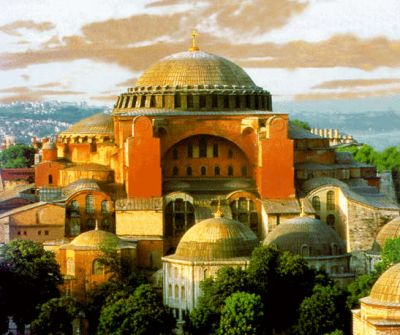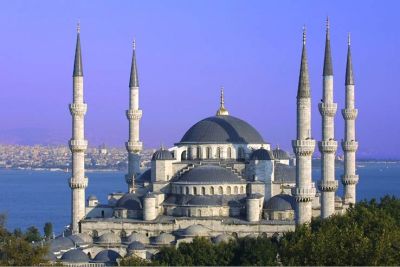 Stories filed at the end of Pope Benedict XVI's trip to Turkey highlighted his visit to -- and prayer inside -- a Muslim mosque. That's a good thing, since it's very newsworthy when a leader of the Christian religion worships or prays in a place of worship for non-Christians.
I was going to highlight various stories from the BBC, the Los Angeles Times, and Reuters this weekend, but other events got in the way.
Stories filed at the end of Pope Benedict XVI's trip to Turkey highlighted his visit to -- and prayer inside -- a Muslim mosque. That's a good thing, since it's very newsworthy when a leader of the Christian religion worships or prays in a place of worship for non-Christians.
I was going to highlight various stories from the BBC, the Los Angeles Times, and Reuters this weekend, but other events got in the way.
I thought most of the stories did a great job of accurately representing the facts of the pope's visits to Hagia Sophia and the Blue Mosque across the street. And most of the stories even did a good job of highlighting the significance to Muslims of the prayer inside the mosque, facing Mecca. And the significance to Muslims of his failure to pray inside the Hagia Sophia was fleshed out, as evidenced by this section from the Los Angeles Times' Tracy Wilkinson:
The pope avoided potential controversy in a visit to the Hagia Sophia, an imposing structure built in the 6th century as a Byzantine church and converted to a mosque in the 15th century by Ottoman sultans. The rigidly secular forces that formed modern Turkey in the early 20th century turned the Hagia Sophia into a museum, one of Istanbul's most popular tourist destinations where public displays of worship are banned.
The mere suggestion that the pope might pray there had enraged Turkish nationalists. When the late Pope Paul VI came to Istanbul in 1967, he knelt to pray in the Hagia Sophia, touching off protests by extremists who were convinced that he was trying to reassert Christian jurisdiction over the site.
Benedict visited the vast museum of domes and minarets, an incongruous combination of Muslim and Christian features, in more restrained fashion. He refrained from any overt religious gestures and instead listened to explanations from his host, Istanbul Governor Muammer Guler.
What was lacking, in my view, was a look at the significance of each visit for Christians. Members of the Catholic blogosphere were expressing disappointment or support for the pope's decisions, but the mainstream media coverage didn't seem to pick up on it. To that end, I was pleasantly surprised to see a nicely written piece of in-depth analysis from The New York Times' Ian Fisher. He covered the story all week before providing a lookback on Sunday:
Has the pope gone wobbly?
The question might matter less if he weren't the man he is -- and if the images of his facing Mecca in prayer on his trip to Turkey weren't fresh. Supporters have long depended on Benedict XVI for brave talk, even and maybe especially if it was unpleasant to hear. But his was never mere blunt confrontation. With his big brain and the heft of Roman Catholic tradition behind him, Benedict has stood for a remarkably clear idea: there is truth, and we won't retreat from it.
 The piece covers varying views from Catholics and puts it all in the context of what the Turkey visit indicates about what kind of papacy Benedict will have. It's got more attitude than a typical mainstream media piece, but it balances everything out nicely and is remarkably fair and sympathetic to Benedict's new tone. While it's an op-ed, another piece worth checking out ran in today's Los Angeles Times. Raymond Ibrahim, a research librarian at the Library of Congress, finds more than a few fascinating aspects to the trip:
The piece covers varying views from Catholics and puts it all in the context of what the Turkey visit indicates about what kind of papacy Benedict will have. It's got more attitude than a typical mainstream media piece, but it balances everything out nicely and is remarkably fair and sympathetic to Benedict's new tone. While it's an op-ed, another piece worth checking out ran in today's Los Angeles Times. Raymond Ibrahim, a research librarian at the Library of Congress, finds more than a few fascinating aspects to the trip:
In the days before Pope Benedict XVI's visit last Thursday to the Hagia Sophia complex in Istanbul, Muslims and Turks expressed fear, apprehension and rage. "The risk," according to Turkey's independent newspaper Vatan, "is that Benedict will send Turkey's Muslims and much of the Islamic world into paroxysms of fury if there is any perception that the pope is trying to re-appropriate a Christian center that fell to Muslims." Apparently making the sign of the cross or any other gesture of Christian worship in Hagia Sophia constitutes such a sacrilege.
Built in the 6th century, Hagia Sophia -- Greek for "Holy Wisdom" -- was Christendom's greatest and most celebrated church. After parrying centuries of jihadi thrusts from Arabs, Constantinople -- now Istanbul -- was finally sacked by Turks in 1453, and Hagia Sophia's crosses were desecrated, its icons defaced. Along with thousands of other churches in the Byzantine Empire, it was immediately converted into a mosque, the tall minarets of Islam surrounding it in triumph. Nearly 500 years later, in 1935, as part of reformer Kemal Ataturk's drive to modernize Turkey, Hagia Sophia was secularized and transformed into a museum.
The piece, using rather strong language, argues against providing Muslims with special treatment. Whether or not you agree with the argument, it's worth asking whether reporters implicitly did just that by focusing on the Muslim reaction to Benedict's trip while largely ignoring the Christian reaction.
